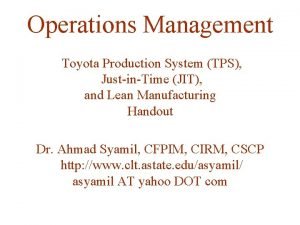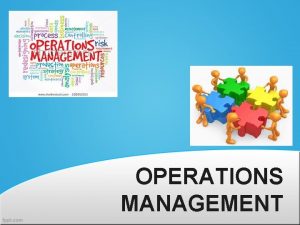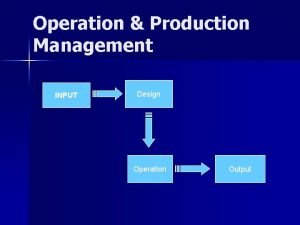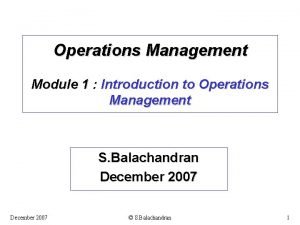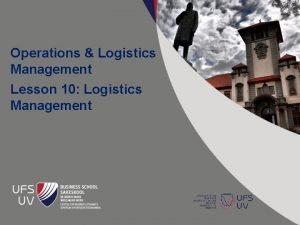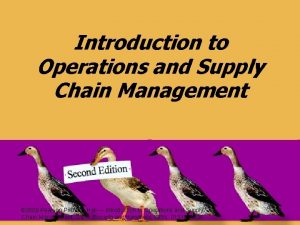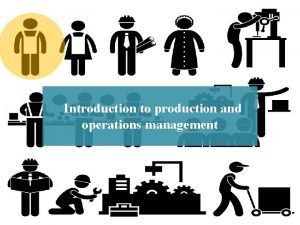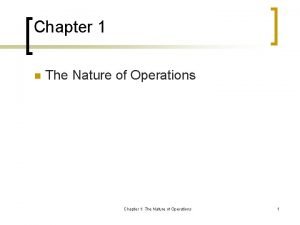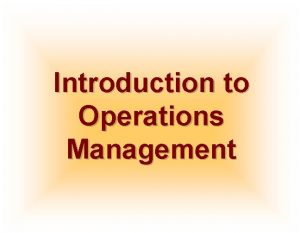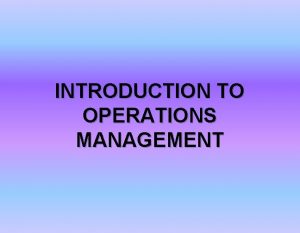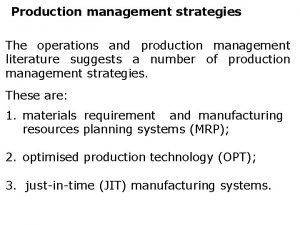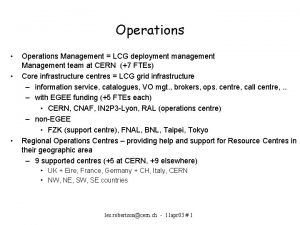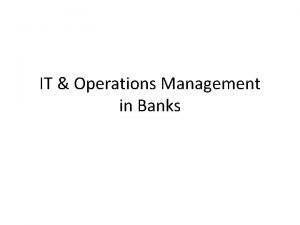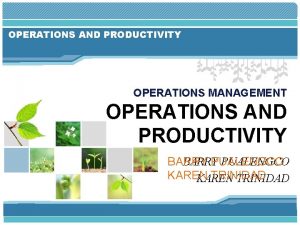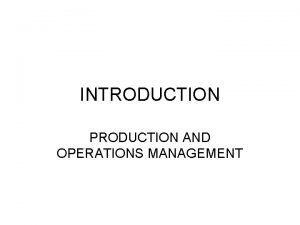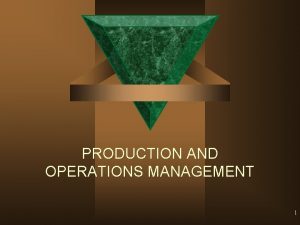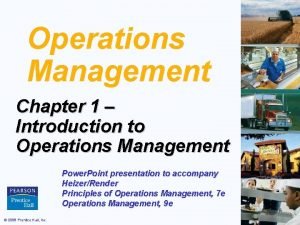Introduction to Production Operations Management Nature of Production













- Slides: 13

Introduction to Production & Operations Management

Nature of Production • In an industrial organization, production is the most important functional area • Production is the process by which inputs are converted into output • Usually, the term production and manufacturing is used interchangeably, but both the terms are different in management. • Manufacturing is used in the case of tangible goods and production includes both tangible gods as well as services. • Production can be easily understood if we view the manufacturing function from three angles: – Production as a system – Production as an organizational function – Production as a decision making function

PRODUCTION AS A SYSTEM • A system is understood as a whole that functions with the help of various sub-components. From this angel, production comprises of three sytems: • PRODUCTION SYSTEM • CONVERSION SUB-SYSTEM • CONTROL SUB-SYSTEM

PRODUCTION AS A SYSTEM PRODUCTION SYSTEM CONCEPTS CONCEPT DEFINITION 1. Production System A system whose function is to convert a set of inputs into a set of desired outputs 2. Conversion Sub-System A sub system of the larger production system where inputs are converted into outputs 3. Control sub-system A sub system of the larger production system where a portion of the output is monitored for feedback signals to provide corrective action if required

PRODUCTION AS AN ORGANIZATIONAL FUNCTION • The core of production system is its conversion sub-system , wherein workers , materials and machines are used to convert inputs into products and services. • This process of conversion is the heart of production function in an organization where manufacturing is the key process.

PRODUCTION AS DECISION MAKING SYSTEM • The operations manager in an organization need to take various decisions related to production function. • They plan , organize, staff, direct and control all the activities in the process of production. • The decisions taken by operations manager related to production falls into three general level of categories. They are:

PRODUCTION AS DECISION MAKING SYSTEM 1. STRATEGIC DECISIONS § These decisions are major ones have strategic importance in production 1. OPERATING DECISIONS § These decisions are related to planning production to meet demand 1. CONTROL DECISIONS § These decisions relates to planning and controlling operations

Types of Decisions - Strategic Type of Decisions Strategic Decisions Area of Involvement Production Process Nature of Activities Developing long range production plans Production Technology Selecting and managing production technology Facility Layout Planning the arrangement of facilities Allocating resources to strategic alternatives Planning for the optimal distribution of scarce resources among product lines or business units Long range capacity Answering ‘how much’ and ‘where’ questions about long range production capacity

Types of Decisions – Operating Decisions Type of Decisions Operating Decisions Area of Involvement Nature of Activities Production planning system Aggregate planning and master production scheduling Independent demand inventory system Planning and controlling finished goods inventories Resource requirement planning system Planning materials and capacity requirements Shop floor planning and control at each work center Short range decisions about what to produce and when to produce Materials management Managing all facets of material system

Types of Decisions – Control Decisions Type of Decisions Control Decisions Area of Involvement Nature of Activities Productivity and employees Planning for effective and efficient use of human resources in operations Total quality control Planning and controlling the quality of products and services Project planning and control Planning and controlling techniques projects Maintenance management and reliability Planning for maintaining the machines and facilities of production

DISTINCTION BETWEEN PRODUCTION & OPERATIONS MANAGEMENT • Even though both the terms are used frequently together, there exists at least two distinctions between the two terms. They are: 1. The term production management is used for a system where tangible goods are produced whereas operations management is more frequently used where various inputs are transformed into intangible services. § Viewed from this perspective, operations management will cover services such as banks, airlines, utilities, pollution control agencies, super bazaars, educational institutions, libraries etc. in addition to the manufacturing enterprises 2. The second difference is the evolution of the term as operations management is a term used nowadays. Production management precedes operations management in the historical perspective of the growth of the subject.

RECENT TRENDS IN PRODUCTIONS AND OPERATIONS MANAGEMENT 1. Global market place 2. Production/operations strategy 3. TQM 4. Flexibility 5. Time Reduction 6. Technology 7. Worker involvement 8. Re-engineering 9. Environmental issues 10. Corporate downsizing 11. Supply chain management 12. Lean production

Product A Product B • Feature 1 • Feature 2 • Feature 3
 Membuat alur proses produksi multimedia
Membuat alur proses produksi multimedia Production
Production Introduction to production management
Introduction to production management Product design process in operations management
Product design process in operations management Nature of production management
Nature of production management Introduction to operations management module
Introduction to operations management module Introduction to operations and supply chain management
Introduction to operations and supply chain management Operation manager function
Operation manager function Introduction to operations and supply chain management
Introduction to operations and supply chain management Introduction to production management
Introduction to production management Quality management in operations management
Quality management in operations management Operations management chapter 12 inventory management
Operations management chapter 12 inventory management What is tqm
What is tqm Nature of operations
Nature of operations

